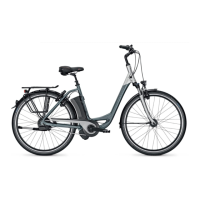12 VII User Manual | Pedelec Groove
6.3 Riding your Pedelec eciently
You can monitor and inuence the cost of your journeys
with the Pedelec yourself. You can reduce your consump-
tion and therefore costs by following the tips for achieving
a long range.
The operating costs for battery-operated power assist are
calculated as follows:
• A new battery costs roughly 359euros.
• You can cover 45km on average with one battery
charge.
• You can charge the battery roughly 1,100 times.
• 1,100 charging cycles x 45km = 49,500km
• 359euros: 49,500km = 0.7euro cents / km
• You use roughly 0.47kWh to lly charge the bat-
tery. Assuming a unit price of 20euro cents / kWh,
it costs you 9.4euro cents to lly charge the bat-
tery.
• It costs you 0.2 euro cents / km to cover the aver-
age range of 45 km.
• This means that the maximum cost of consumption
and the battery is 0.9euro cents/km.
The sample calculation has been carried out based on Ger-
man energy prices. The operating costs may therefore be
dierent in locations where other energy prices apply.
7 Battery
Your battery is a lithium cobalt battery, the ideal lithium-
ion (Li-Ion) battery type for this application. One of the
main benets of this type of battery is its low weight
combined with a high capacity. Li-Ion batteries only weigh
half as much as comparable nickel metal hydride or nick-
el-cadmium batteries. This means you carry less battery
weight and more battery power.
7.1 Straightforward charging
› There is no memory eect. You can therefore lly
recharge your battery aer every trip.
› Recharge the battery aer every trip. This means
you can set o immediately the next time you use
your bike and you also increase the service life of
the battery.
› If you are not using the battery, you only have to
recharge it aer 6 months.
7.2 High degree of safety due to battery
management
› The battery cannot be damaged as a result of a
short-circuit. If this were to happen, the battery
management would switch o the battery.
› You can simply leave the battery standing in the
charger as the device has in-built overcharging
protection.
7.3 Straightforward storage
› If you do not need your battery for a while, store it
at a temperature of +10°C when the battery charge
is between 50 and 75%.
These benets are available due to highly eective battery
management that has been adapted to this specic appli-
cation and by tuning the battery for operation with a 250
watt motor.

